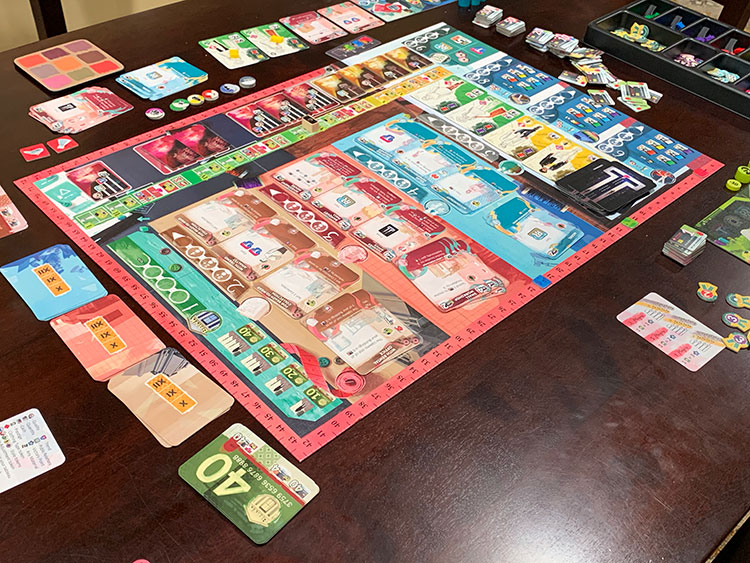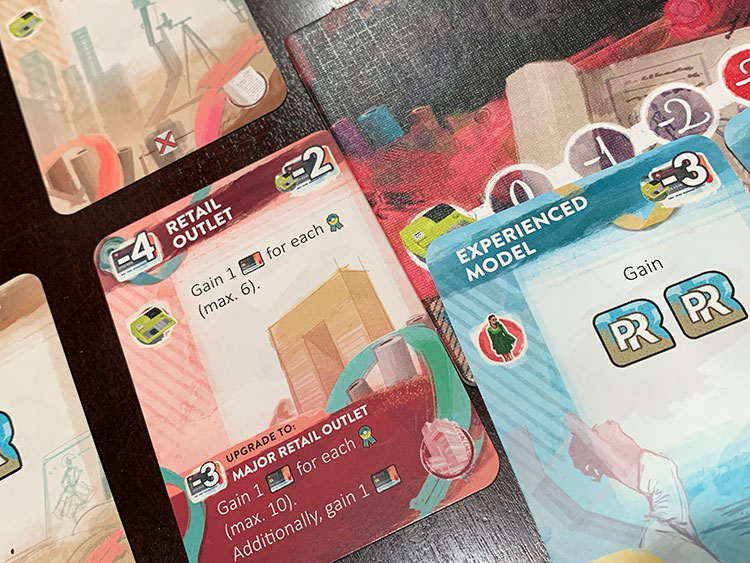 For game designers, themes are difficult. Sometimes the idea for a game comes from wanting to explore a certain theme in a board game. Other times, a board game’s mechanisms are already fleshed out and choosing an appropriate theme to match the mechanisms is necessary. Hopefully, this theme is also something that sparks the interest of potential customers.
For game designers, themes are difficult. Sometimes the idea for a game comes from wanting to explore a certain theme in a board game. Other times, a board game’s mechanisms are already fleshed out and choosing an appropriate theme to match the mechanisms is necessary. Hopefully, this theme is also something that sparks the interest of potential customers.
When it comes to economic games, there’s no shortage of potential themes. Buying, selling, making products, and improving a business hits the veins of many gamers like caffeine for a coffee fiend. This enjoyment is akin to a civilization game as players feel the impact of their own decisions as their card empire spreads before them.
Even a game with a theme of running a high fashion label can feed this hunger. Pret-a-Porter, a worker placement, tableau-building opus is just such a game. The original was released in 2010, however, it’s recently received a makeover and deserves a second look. Up to 4 players can walk the runway with designs to impress critics, win awards, and make money in this economic sim. For the most oohs and aahs, make sure you have 3 or 4 trend-setters dahling.
Gameplay Overview:
The course of play is simple. Pret-a-Porter (forgive us, French speakers, if we miss accents for the vowels) progresses through a series of rounds of two types. There are working rounds and exhibition rounds. During working rounds, players use their worker-tokens to take actions at various spaces on the board. On an exhibition round, players will show off completed designs to earn awards for points and make money to further their enterprise.

There are six primary areas to place workers:
- The Bank – Players can get loans to further their business building. Money is needed to pay workers, acquire fabric, and improve/add business locations.
- Contracts – These cards offer temporary bonuses that become weaker with each use.
- Locations – If a player wants more than 3 employees, they’ll need new locations for them to work. These cards can also combo with other abilities to help players make money or receive discounts on resources.
- Employees – Some of the strongest cards in the game are improved workers who can help players gain awards or manage their finances.
- Designs – To put on a fashion show, players will want to collect cards of a specific fashion style (business, casual, sport, etc) and for a specific type (jacket, top, bottom, dress, etc). These are the cards that players will be chasing the whole game to impress critics.
- Acquire Fabric – Finally, in order to complete designs, players need fabric. There are various locations of various levels of quality. Acquiring higher quality fabric is key to winning certain awards, as long as that’s what the judge’s value more that season.
During exhibition rounds, a set of judging tokens indicates which aspects of fashion are the most important that season. These could be quality, trendiness, public opinion, or number and variety of designs. If a player has the most of the indicated item during an exhibition round, they win a varying number of awards based on the importance of that to the judges. Since the judging tokens change with each game, strategies can also be different from game to game. The end of game award categories also heightens the drama with the end of the year fashion show providing the most awards. The award tokens received convert into victory points based on player count.
After 12 rounds, the player with the most points + money in hand wins.

Game Experience:
The first thing everyone will likely notice is how gorgeous this new edition of the game is. Every component is solid. The art is easy to digest and enhances the theme without sacrificing any usability. The most “fun” component usually is the money tokens, which look like little credit cards.

However, a noticeable and frustrating weakness to this is that the manual does not follow the board references in all cases. Specifically, the round tracker doesn’t match the phases in the rules. The iconography is helpful, but with the two using different symbology, it makes a first play frustrating. If the rules had simply been updated to follow the board art, it would have made everything clearer.
The other, more annoying negative is that the game really isn’t great at 2 players. There are some idiosyncrasies that make the second player have a disadvantage with how the first player token passes. In addition, blocking worker spaces just isn’t that cutthroat. It’s very easy to get what you need so the game really comes down to uninteresting decisions in avoiding the opponent.

However, when you do have 3 or 4 players, the economic decisions in the game are solid and enjoyable. The theme struts through the game just like a high fashion model. The competition is fierce around player choices focused on winning awards. The feel here is similar to a more subtle set collection mechanism with points awarded for the most valuable sets.
Unfortunately, the negative is that as an economic game, Pret-a-Porter is prone to the rich getting richer. Since every round results in the sell-off of dresses, it is possible that players will focus purely on money for points. And here, it’s easy to buy valuable cards to enhance your profits while poorer players struggle to grab as many awards as they can without going bankrupt. However, when played with a group of players who are all well experienced, the gameplay shines.

Final Thoughts:
Pret-a-Porter is good. It’s very good. It’s fun, engaging, and one of the few games where a different economic theme shines to match the gameplay. It could be better, and the new art is certainly a step in the right direction. There are still some problems in Pret-a-Porter that stick out like men’s jorts on a catwalk. These aren’t big enough faux pas’ to sway gamer fashionistas looking for one of the few games with the theme, but for casual players who may need a bit of a level playing field, it is a noticeable stumble.
Final Score: 3.5 stars – This updated version of a 2010 head-turner will turn even more heads with its new look. Just don’t expect the gameplay to be forgiving.
 Hits:
Hits:
Gorgeous new art
High stakes fashion economic competition
Cute components
Misses:
Experienced players can crush new players
Not really great at 2 players





















